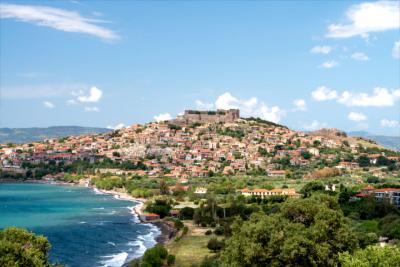Travel Offers
Travelmyne Featureprint
Distance
Samos - The Green Beauty of the Aegean
It is one of the greenest islands in the Aegean Sea and combines natural sights with cultural and historical attractions. Samos is an island which impresses in a number of different ways.

Geography - The heart of the Southern Sporades
The island of Samos is one of the most popular holiday destinations in Greece and belongs to the political region of the North Aegean. Geographically speaking, the island is part of the Southern Sporades. It is located very close to the Turkish mainland (about two kilometres away) and has a total area of 477,395 km². Samos is divided into four municipalities and has about 33,000 inhabitants. The capital and administrative centre is the town of Vathy. Other popular destinations are Pythagorio, Kokkari, Karlovasi as well as the villages of Pyrgos and Marathokampos. While there are several uninhabited islands north-east of Samos, the only island which belongs to Samos and is populated is Samiopoula in front of the south coast. The climate is warm temperate and characterised by mild, rainy winters and warm, dry summers.

Nature - A delicate odour of Mediterranean herbs
Due to its proximity to the mainland, Samos is one of the most fertile and well watered islands in the whole of the Aegean Sea. It is characterised by a unique diversity of plants. The island is heavily forested with a mix of stone pines, oaks, cypresses, carob and walnut trees. Furthermore, you find vast areas with vineyards, olive groves, tobacco plantations, corn fields and fruit trees. A major part of the island (about a third) is very flat to hilly with peaks between 150 and 900 metres of height. However, there are also mountainous regions with heights of over 900 metres. Two of these regions are the Kerkis (1,434 m) and the Ambelos (1,153 m). At higher altitudes, you see herbs like thyme, rosemary and oregano between the shrubs, bushes and thistles. They fill the air with a pleasant Mediterranean fragrance. The island's fauna is rich too. With a bit of luck, you can watch numerous mammals and reptiles here. In addition, the island offers stunning beaches with crystal clear water, most of which are located in small bays. Popular beaches are Potokaki, Psili Ammos, Potami, Gagou and Lemonakia Beach as well as Posidonio Bayn. Near Karlovasi, travellers can marvel at the beautiful Potami Waterfalls.

Culture - From Hera to Pythagoras
Samos was one of the most significant islands in ancient times. It is most of all known as the home of Pythagoras, one of the greatest ancient Greek mathematicians and philosophers. According to Greek mythology, the goddess Hera was born here too. The ruins of a temple complex which were built in honour of the goddess - the Heraion - can be found here. This complex as well as the Tunnel of Eupalinos, which is over one thousand years old, are part of the UNESCO World Cultural Heritage. The main destinations for most travellers are the former capital of Phytagorio and the village of Kokkari. Phytagorio accommodates the ancient harbour of Pythagorion with relics from Greek and Roman times. Significant museums are the Archaeological and the Byzantine Museum in Vathy, the Archaeological Museum in Pythagorio, the Natural History Museum of the Aegean, the Historical and Folklore Museum of Karlovasi as well as the Folklore Museum of Samos. Highlights are the ruins of the thermal bath in Samos, the Genovese Castle, the Castle of Lykourgos and the Tower of Sarakinis in Pythagorio. Other interesting buildings are the island's many monasteries. Examples are Zoodochos Pigi Monastery, the Monastery of the Holy Trinity, the Monastery of Profitis Ilias, the Monastery of Megali Panagia and the Monastery of Agia Zoni.

Experience - Between tradition and modernity
There are two kinds of villages on Samos: those who have adjusted to tourism to offer travellers all services and facilities and those who have maintained their nativeness. Together they constitute a pleasant mix of tradition and modernity. Like most Greek islands, Samos has a vibrant nightlife. You find most bars and clubs in the capital of Vathy but also in Pythagorio and Karlovasi. A delicious local speciality is Soima, a drink which is made of grape juice and a special honey. Travellers should also taste the local wine and sparkling wine. There are many festivals on Samos throughout the year. Examples are the festival celebrating St. Hellias in Karlovasi, during which you can try a special meat and wheat dish called "giorti", the Fisherman Festival in Pythagorio and a festival in commemoration of the reunification of the island and Greece. Great shopping destinations are the bigger towns. Popular souvenirs are bottles of local wine or ouzo and Pythagorean cups. Besides products such as leatherware, jewellery, clothes and antiquities, you can also buy a special woollen blanket called "flokati".

Activities - Exploring beaches, caves and mountains
While the beaches are excellently suited for doing water sports such as surfing, windsurfing, bathing, fishing, diving and snorkelling, travellers can go hiking and mountain biking on shore. The best destinations for going climbing are Potami, Tsambou, Efpalinio and Zoodochou Pigis. Visitors should definitely not miss out on a visit to one of the caves, for example Pythagoras Cave, the Cave of Nerotrouvia and the Cave of Sarandaskaliotissa. It is a good idea to rent a car or motorcycle to explore the island. Boats travel to the island of Samiopoula every day.

Information
The best time for a trip to Samos is between Easter and the middle of October. Most hotels are opened during this time. Travellers can arrive at Samos Airport or by ferry from one of the Greek islands (Lesbos, Chios and Limnos) or the mainland (Kavala and Piraeus).
Travellers who are looking for the perfect balance between nature and culture are right on Samos. The island offers caves, waterfalls and beaches as well as fascinating cultural sites and museums.




